This post looks at two further examples of the use of plastic tree tubes (see here and here), this time on the western side of the Cairngorms National Park, argues that their use is completely unjustified and it is time they were banned completely.
The use of plastic tree tubes in the A9 dualling project
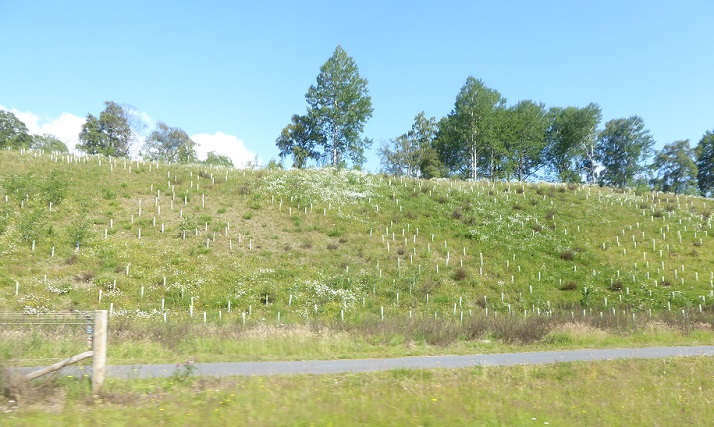
The 7.5 miles section of dual carriageway along the A9 between Kincraig and Aviemore that opened in 2017 – the same year as David Attenborough’s Blue Planet II, the programme which brought to public attention the levels of plastic in our oceans – is now bordered by a sea plastic tree tubes. Somehow, when commenting in 2018 on the impact of the decision to fence the new A9 (see here), I failed to mention the tree tubes. Mea culpa. We need to see these tubes for what they are, an affront to nature.
The construction of this section of the A9 involved the destruction of woodland, some of it ancient, and it was decided to “mitigate” the impact of this by planting trees along the new embankments with their completely different soils. (A useful map from Transport Scotland map (see here) explains the original proposals). With the main damage done, the decision to plant was in my view totally misguided, a fig leaf, and the Cairngorms National Park Authority should have opposed this and argued for natural regeneration, letting nature do the work, based on the inspiring examples elsewhere within the catchment of the River Spey and the recommendations of Scottish Natural Heritage back in 2004 (see here):
“Natural regeneration is the preferred option for creating new native woods or restoring Plantations on
Ancient Woodland Sites (PAWS)”
What’s more, the usual arguments that are used to justify planting trees, rather than leaving it to regenerate naturally, clearly didn’t apply in this case: the area was fenced, so there was no pressure from browsing herbivores, and a seed source, the surviving woodland adjacent to the construction corridor, couldn’t have been closer.
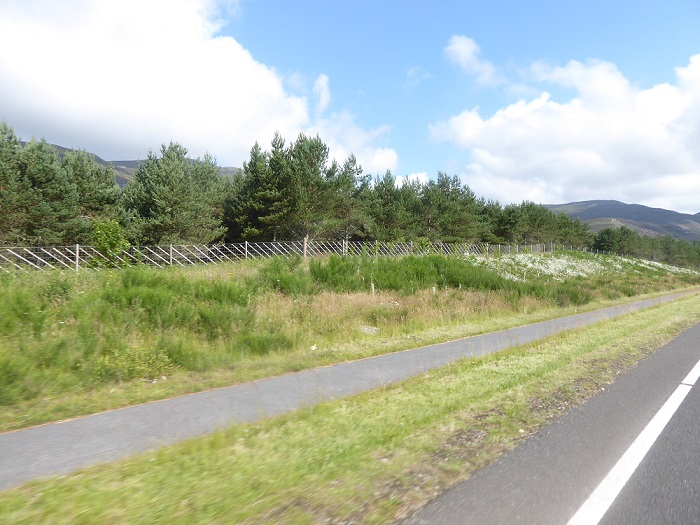
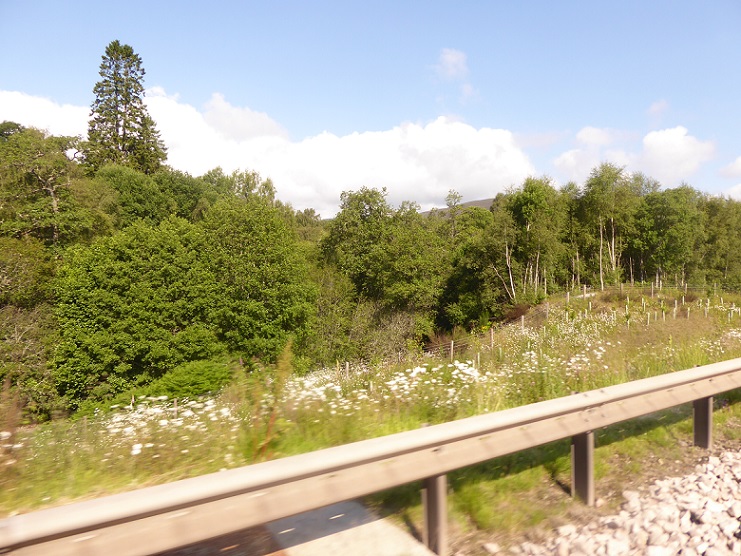
The use of plastic trees guards in areas such as this is now contrary to official advice produced by Forestry England in 2020 (Forestry Scotland doesn’t appear to have produced any such advice)(see here):
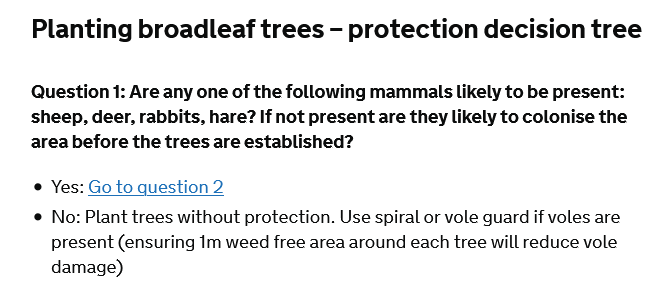
The dualled section of A9 is enclosed by deer fencing – to prevent car accidents – and it is unlikely that after the construction had finished a single rabbit or hare survived within the enclosure so the answer to Question 1 is no. Moreover, the likelihood of numbers of larger grazing mammals increasing in the future is small because of road kill and because any sizable population of rabbits and hares would also be likely to attract buzzards (even if other predators like foxes were unable to get through the deer fencing).
The only reason why trees planted here might have needed protection therefore was because of voles. But it is tree guards, not vole guards that have been used.
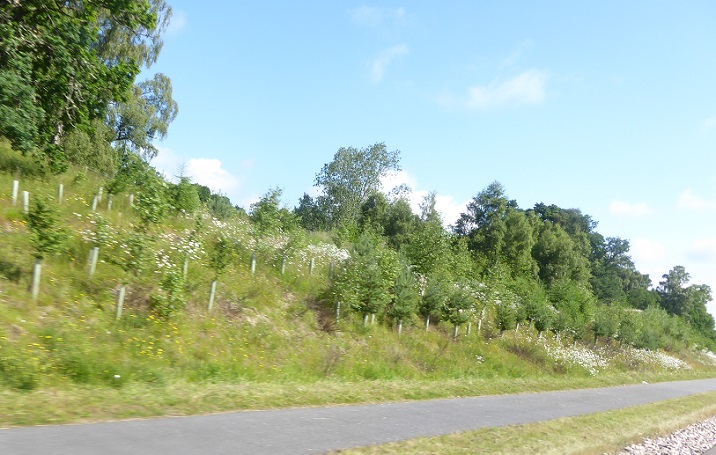
These tree guards have even been used to “protect” conifers, which are much less likely to be browsed by voles and which have been planted in their hundreds of thousands in industrial scale plantations without any such protection. There is no justification for this but still our public authorities allowed it to happen.
Planting hundreds of trees in close proximity at the same time would, of course, provide a plentiful new food source, particularly over the hard winter months, and that could help trigger an explosion in the vole population. But if that is the case, why not avoid boom and bust and phase the planting of trees. Currently, that rarely happens as its seen to be too expensive. That financial accounting takes no account of the potential to create new jobs or the cost of plastic, both in terms of carbon emissions into the atmosphere and of its impact on the natural environment.
I listened to an interesting programme on Inside Science on the BBC on 17th June (see here) in which researchers had concluded that the carbon cost of plastic tree tubes is on average never offset by the gains in tree survival or growth rates and their used can only be justified in certain circumstances and where recycling can be guaranteed. Concerns about those carbon and environmental costs appears to have contributed to the recent decisions by both the National Trust (see here) and the Woodland Trust (see here) to discontinue the use of plastic tree tubes.
Unfortunately, while there is growing recognition of the advantages of natural regeneration over planting (see here), the Scottish Government and our Public Authorities have carried on using tree tubes regardless:
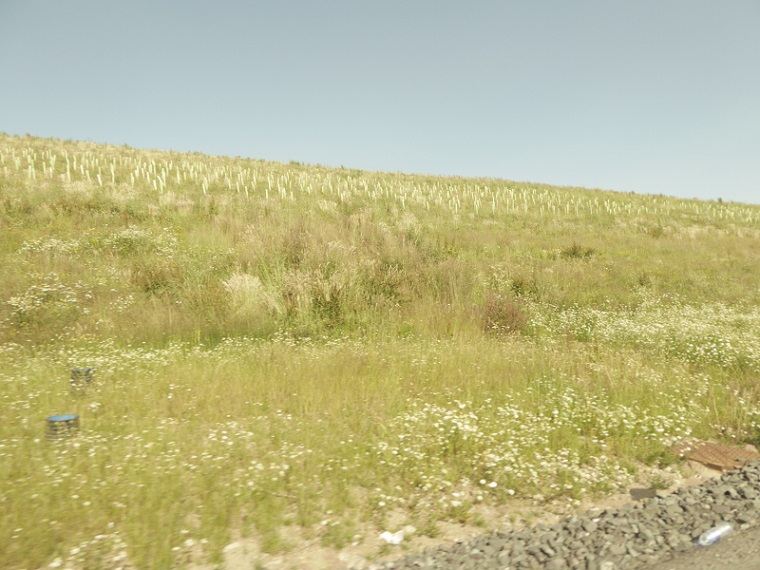
My impression is that Transport Scotland has allowed the A9 to be peppered in plastic, simply because that is what their landscape consultants advise what is needed. There are vested interests here as any advice that tree planting and the use of tree guards was unnecessary would threaten certain jobs (even if it could also create new ones). In such situations we need our Public Authorities – and particularly our National Park Authorities – to show some leadership and tackle those vested interests.
The Glen Markie native woodland scheme
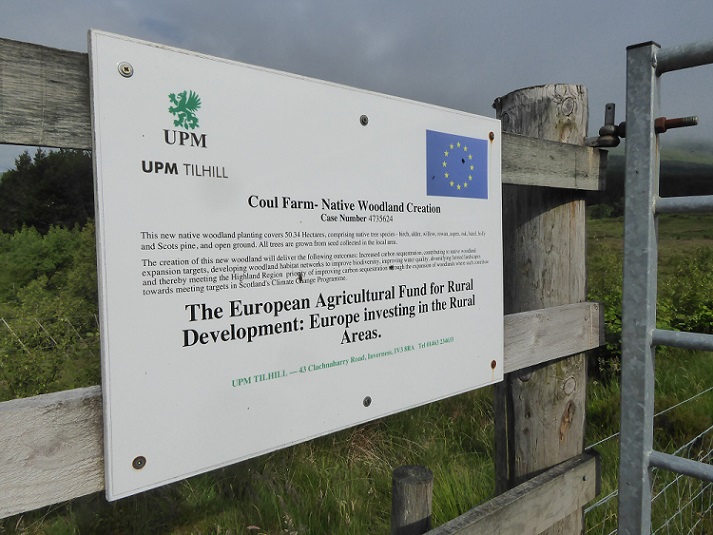
Walking up Glen Markie from the Spey Dam to the Munro Geal Charn, which sits astride the National Park boundary, the track passes through the Coul Farm Native Woodland Scheme. The only details about the scheme I have been able to find are the archaeological assessment (see here) which dates from 2012. The woodland planting near the gate showed no signs of any plastic tree guards: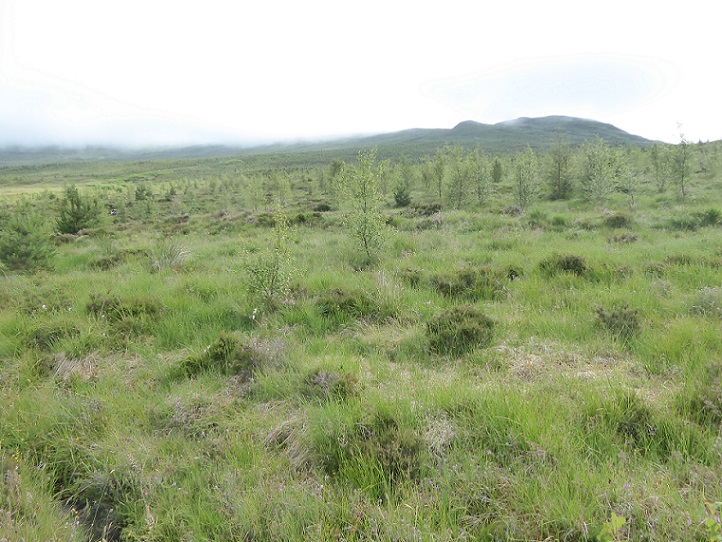 But then, a little further on, the track passes through a stunted forest of plastic tree tubes just above the Glen Markie Burn (which, while not itself protected, flows into the River Spey Special Area of Conservation):
But then, a little further on, the track passes through a stunted forest of plastic tree tubes just above the Glen Markie Burn (which, while not itself protected, flows into the River Spey Special Area of Conservation):
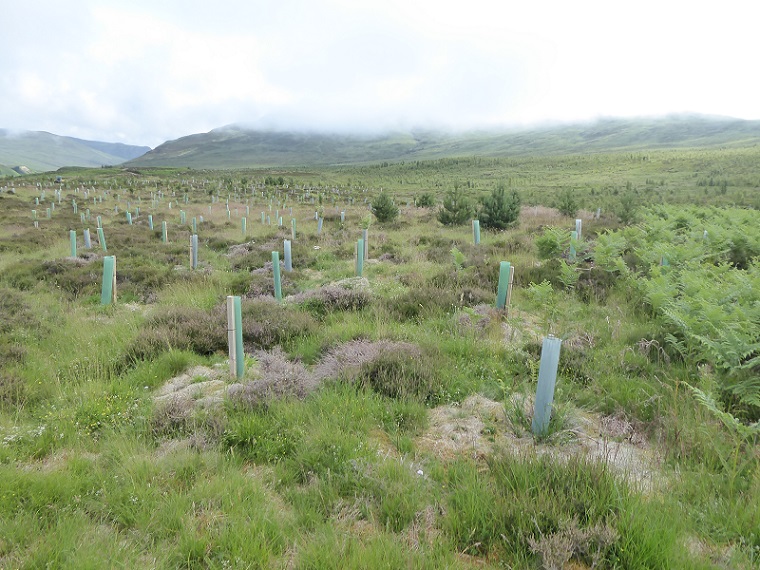
The tree tube planting by the sides of the track appeared to me to have been undertaken at a later date to the original planting:
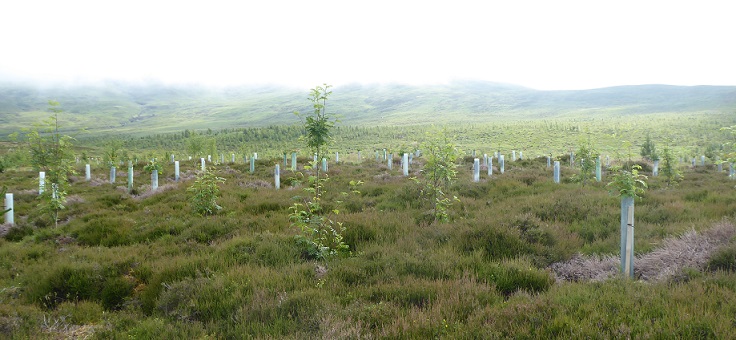
Perhaps some of the deciduous trees originally planted here had failed to take? If so, it would be interesting to know why and on what basis Tilhill decided to plant more trees in plastic tubes.
Whatever the explanation, it was clear that a high proportion of the plastic tree tubes hadn’t worked:
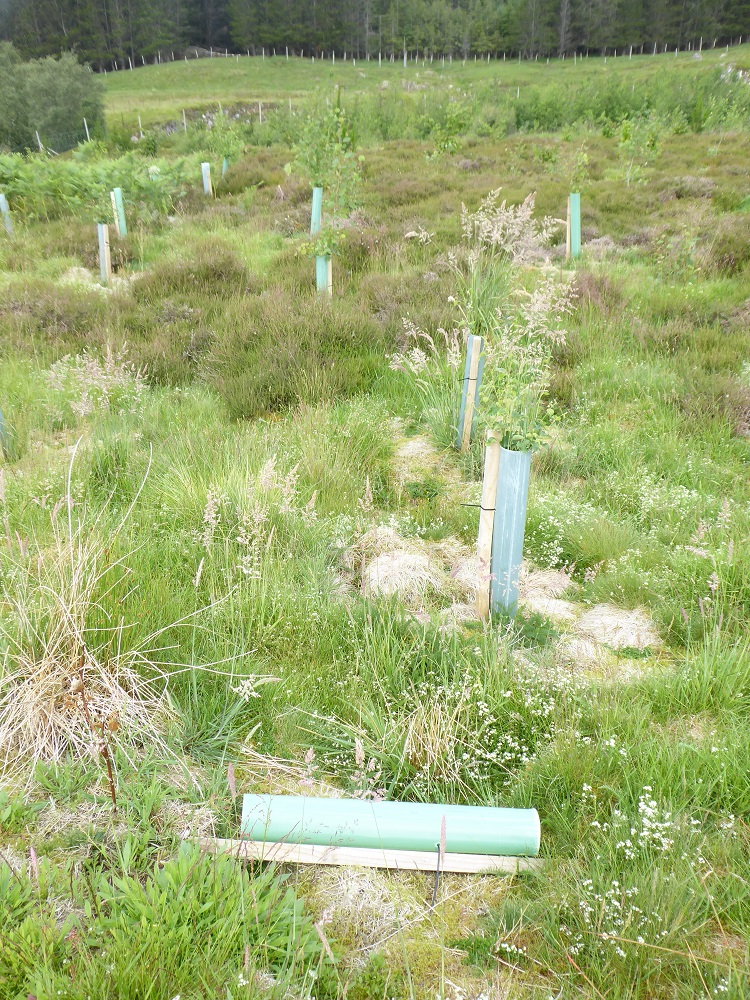


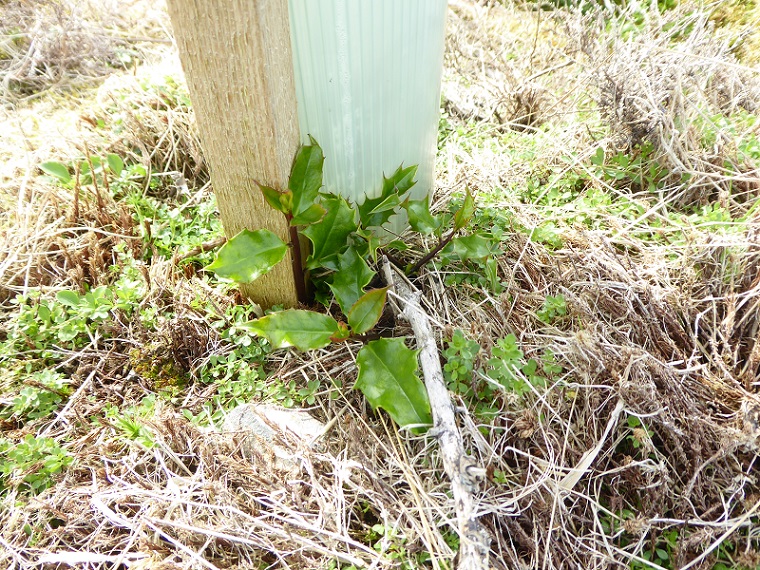
So why do we keep doing this and in a National Park to boot?
The problem – and its worth noting that this scheme was funded through the EU – is that the current forestry grant system for native woodland is based around planting trees, rather than reducing the numbers of deer and managing grazing by livestock in a way that promotes natural regeneration. As a consequence, public money is devoted to putting up deer fences (that keep us off the land and kill birds like capercaillie) and installing tree tubes, which have terrible consequences for the natural environment and whose importance for woodland regeneration has been grossly exaggerated.
This plays into the hands of sporting estates, who are allowed to burn and graze the land to destruction in the name of sport, while public money is used to create new native woodland areas which they then develop for pheasant shooting:
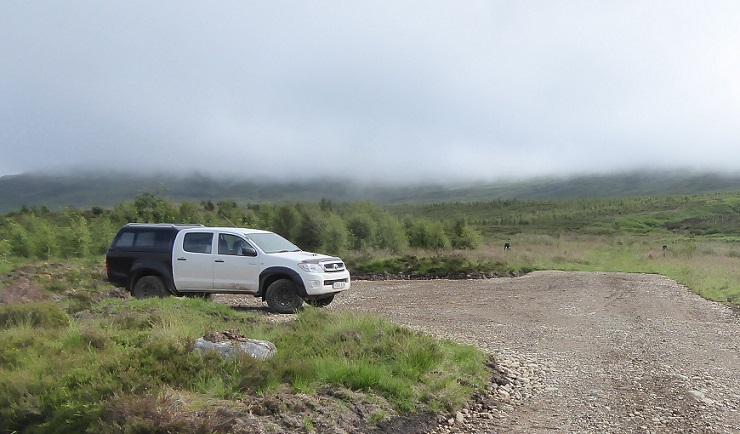
What needs to happen?
The crazy grant system, which promotes the use of plastic tree tubes, is perpetuated by a number of factors.
First, there are the vested interests of the forestry industry as it currently operates.
Second, almost all Scottish Government policy at present is being determined by its wish to re-join the EU. It is therefore extremely reluctant to criticise or change the EU-derived agricultural and forestry payments system. It does not want to create any potential blocks to Scotland re-joining the EU, should independence ever happen, or to open up a debate on how far the EU really served to protect Scotland’s environment..
Third, the system is also perpetuated by land-owning charities like the Woodland Trust (there are many others) who will ask the public to put their hand in a pocket to plant a tree – it sounds like such a good thing – but never dare explain or ask for money to address the real problem, the very high numbers of red deer. Hence too why the Woodland Trust, while making the welcome announcement that it will stop using plastic tree tubes, continues to argue that fencing as essential, as in its involvement in the misconceived native woodland planting in Glen Banchor (see here).
Its time the public said enough is enough. Plastic tree tubes are such an obvious affront to nature that we should be calling for them to be banned immediately. An announcement by the Scottish Government to this effect in time for COP26 in Glasgow is what the public should be going for. But that then needs to be followed up by calls for a shift in public subsidies for land-management, away from planting trees and towards reducing grazing pressure so that native woodland can start to regenerate naturally.
Believe your local council is planning to plant 1 tree per head of population in and around Glasgow.
Will be interesting where they and how they plant them and what the outcomes are.
I believe a lot are planned for what up until now were local municipal golf courses. Whether more people will visit the new woods than were visiting the golf courses remains to be seen. Meantime, the city has been failing to plant trees where planting really is the sensible way forward, along our streets. Old trees are dying and not replaced while the expanses of tarmac – terrible for flooding and carbon absorption – grow ever larger……………what is worth saying is that natural regeneration plays an important role in cities, just like in the countryside, as you can see along any railway embankment or on any derelict building. Most years some new trees or shrub seeds in our small garden, this year its a a buddleia.
Interesting comments on the scourge of plastic tubes now blighting our landscapes, particularly along the new sections of the A9. Older readers may recall that when the new A9 road was constructed in the 1970’s, much of the exposed mineral soils on the banking at the roadsides were left virtually untouched. Within a few years carpets of tree seedlings covered these roadsides. Mother Nature is a great healer and she has the added benefit of incurring no financial penalty on the tax payer.
There is a more serious side to these plastic tubes which affects every living thing and is why they should be not only banned but there use being made illegal, PLASTIC IN THE FOOD CHAIN! A recent TV programme carried out research into some well known soft drinks in plastic bottles and also those supplied in cans. Despite the drinks companies claiming water used in the manufacture of the drinks is filtered before use, plastic was found in both sets of containers, with the plastic bottles having the higher concentration of the two, but the plastic was found in metal containers as well.We are all now eating and drinking plastics every day which cannot be healthy! While everyone is jumping on the climate change bandwagon, are we slowly poisoning ourselves anyway to the point where climate change will sort itself out because there is no life left creating carbon emissions?
I agree that tree tubes are a blight, but as you must know controlling deer nunbers is easier said than done, especially for smaller scale landowners, if your neighbours won’t cooperate. Maybe your target here should be NatureScot who seem to be completely incapable (or just unwilling) to take measures to ensure deer populations are reduced to anything like sustainable levels.
PS Forestry Commission (UK) doesn’t exist – your link is to Forestry Commission England
I absolutely agree that small landowners (and people with gardens in rural areas for that matter) are in a very difficult position and the problem lies with NatureScot’s failure to take on the larger landowners. In my recent post on Glen Banchor I called on them to use their compulsory powers under Section 8 of the Deer Act and will keep doing so. I referred to Forestry Commission (UK) because I did not check the date of the guidance and wrongly assumed it dated from Forestry Commission days. It was produced last year and is indeed a Forestry England publication, so I have corrected the post, thank you. I can find no equivalent for Forestry Scotland.